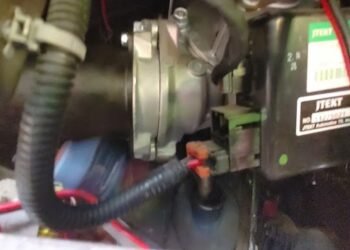Car overheating is a common issue that can lead to serious problems. If your car overheated and then died, you’re likely frustrated and concerned.
Imagine you’re driving on a hot day, and suddenly, you notice the temperature gauge rising. Before you know it, steam is billowing from the hood, and the engine stops. This scenario can be both alarming and inconvenient. Understanding why your car overheated and died is crucial.
It helps you prevent future occurrences and avoid costly repairs. In this post, we’ll explore the main causes of car overheating. We’ll also offer tips on what to do if it happens to you. Stay informed and keep your vehicle running smoothly.

Credit: abc7chicago.com
Signs Of Overheating
Recognizing the signs of an overheating car can save you from a breakdown. Knowing these signals helps you act quickly and avoid costly repairs. Here are some common signs to watch out for:
Temperature Gauge Warning
The temperature gauge on your dashboard is a key indicator. When the needle moves towards the red zone, your engine is overheating. This gauge is usually marked with a “C” for cold and an “H” for hot. Pay attention to it while driving. If it moves past the halfway mark, your car may be in trouble.
Steam From The Hood
Seeing steam from under the hood is a clear sign of overheating. This usually means coolant is boiling in the radiator. It looks like smoke but is actually water vapor. Pull over safely if you see steam. Continuing to drive can cause severe engine damage. Let the engine cool before checking under the hood.
Immediate Actions
Experiencing an overheated car can be both stressful and dangerous. It’s important to know the immediate actions to take in such situations to ensure your safety and prevent further damage to your vehicle. Below are the steps you should follow right away.
Turn Off The Engine
The first step is to turn off the engine immediately. This action stops the engine from generating more heat. It also prevents further damage. Your car’s engine needs to cool down. This is crucial.
After turning off the engine, leave the key in the ignition. This keeps the electrical system on. Your car’s cooling fans might still work. They help to cool down the engine faster.
Pull Over Safely
Next, you need to pull over safely. Look for a safe spot on the side of the road. Avoid stopping in the middle of traffic. Use your hazard lights to alert other drivers. This ensures your safety and theirs.
If you are on a busy highway, try to find an exit. A parking lot or a less busy street is safer. Always make sure you are far enough from the road. This avoids the risk of being hit by oncoming traffic.
| Action | Reason |
|---|---|
| Turn Off the Engine | Stops engine from generating heat |
| Pull Over Safely | Ensures your safety and prevents accidents |
Following these immediate actions can help you handle an overheated car effectively. Remember, safety first!
Cooling Down The Engine
Experiencing an overheated car engine can be alarming. The immediate step is to cool down the engine safely. Following these steps ensures you prevent further damage.
Open The Hood
First, pull over to a safe spot. Then, open the hood to let the heat escape. Be cautious; the steam can be very hot. Use a cloth to protect your hands if needed.
Wait For Engine To Cool
After opening the hood, wait for the engine to cool. This may take 30 minutes or more. Do not touch any parts until they are cool to avoid burns.
Once the engine is cool, check the coolant level. Low coolant can cause overheating. Refill if necessary, but ensure the engine is cool before doing so.
Here is a quick checklist to follow:
- Pull over safely
- Open the hood carefully
- Wait for the engine to cool down
- Check the coolant level
- Refill coolant if needed
Following these steps can help manage an overheated engine effectively.
Checking Coolant Levels
Your car overheated and died. It’s stressful. But checking your car’s coolant levels is one of the first steps to getting back on the road. The coolant prevents your engine from overheating. It absorbs and dissipates heat. Low levels can cause your engine to overheat. Follow these steps to check and add coolant.
Locate The Coolant Reservoir
First, you need to find the coolant reservoir. Open your car’s hood. Look for a plastic container. It’s usually near the radiator. Most containers are white or clear. You’ll see a cap labeled “coolant” or “antifreeze.”
Add Coolant If Needed
Check the coolant level. There are usually “MIN” and “MAX” lines on the side of the reservoir. If the level is below “MIN,” add coolant. But do not open the cap while the engine is hot. Wait for it to cool down.
To add coolant, unscrew the cap carefully. Pour in the coolant until it reaches the “MAX” line. Use a funnel to avoid spills. Close the cap tightly after you are done.
It’s important to use the correct type of coolant for your car. Check your car manual or ask a professional. Using the wrong coolant can cause damage.
Inspecting For Leaks
An overheated car can be a big problem. One common cause is a leak in the cooling system. Inspecting for leaks is a critical first step. It helps you identify the source of the problem. This section will guide you through the inspection process.
Look Under The Car
Start by parking the car on a flat surface. Turn off the engine and let it cool down. Safety first. Once the engine is cool, look under the car. Check for any puddles or wet spots. These can be signs of a coolant leak.
Coolant is usually green, orange, or pink. If you see a colorful liquid, it’s likely coolant. Take note of where the liquid is pooling. This can help pinpoint the leak’s location.
Check Hoses And Radiator
Next, open the hood of your car. Inspect the hoses connected to the radiator. Look for cracks, holes, or wear. Hoses can become brittle over time. A damaged hose can easily cause a leak.
Check the radiator itself. Look for any wet spots or corrosion. The radiator’s job is to cool the engine. If it has a leak, the engine can overheat quickly.
| Component | What to Check |
|---|---|
| Hoses | Cracks, holes, wear |
| Radiator | Wet spots, corrosion |
If you find any issues with the hoses or radiator, they need to be repaired or replaced. Don’t ignore small leaks. They can quickly become bigger problems. Regular inspection can save you from costly repairs.

Credit: www.reddit.com
Restarting The Engine
Dealing with an overheated car can be stressful. Knowing how to restart the engine safely can prevent further damage. Follow these steps to get back on the road.
Turn Key To Accessory
First, turn the ignition key to the accessory position. This step is crucial. It allows you to check the car’s systems without starting the engine.
This position lets the electric fan and other systems operate. It helps cool the engine faster. Wait a few minutes before proceeding to the next step.
Monitor Temperature Gauge
Keep a close eye on the temperature gauge. It shows the engine’s current temperature. The gauge should move from hot to normal. Once it reaches a safe level, you can try to restart the engine.
If the gauge stays high, do not start the engine. Wait a bit longer. Keep monitoring the gauge every few minutes. Patience can prevent expensive repairs.
In summary, turning the key to the accessory position and monitoring the temperature gauge are vital steps. They help ensure your engine cools down safely and prevent further overheating.
Seeking Professional Help
If your car overheats and then dies, it can be a stressful experience. It’s important to seek professional help to prevent further damage. This ensures your vehicle is safe to drive. Here are some steps you should take when you face such a situation.
Contact A Mechanic
Contacting a mechanic should be your first step. They have the expertise to diagnose the issue. Explain the symptoms clearly. Mention if there was smoke or strange noises. This helps the mechanic understand the problem better.
- Find a trusted mechanic.
- Describe what happened.
- Include any unusual signs you noticed.
A good mechanic can often identify the problem quickly. They can tell you if the issue is minor or serious. This can save you time and money.
Tow The Vehicle If Necessary
Tow the vehicle if it won’t start again. This prevents further damage. Driving an overheated car can ruin the engine. Call a tow service to move your car safely.
- Contact a tow service.
- Provide your location.
- Ensure the vehicle is moved to a repair shop.
Towing might seem like an extra cost. But it can prevent expensive repairs later. Always choose a reliable tow company. This ensures your car is handled with care.
In summary, professional help is crucial. It ensures the problem is fixed correctly. You avoid potential risks and additional costs.
Preventing Future Overheating
Car overheating can be frustrating. Fortunately, taking simple steps can prevent it. Regular maintenance and checking the coolant are key. Keep your car in top shape with these tips.
Regular Maintenance
Regular maintenance is crucial for preventing overheating. Schedule routine check-ups. Ensure the radiator and cooling system are in good condition. Replace worn-out parts promptly.
| Maintenance Task | Frequency |
|---|---|
| Radiator Flush | Every 2 years |
| Thermostat Check | Every 6 months |
| Coolant Replacement | Every year |
Check Coolant Regularly
Coolant prevents your car from overheating. Check the coolant level monthly. Ensure it is between the min and max marks. Refill if necessary. Use the correct type of coolant for your car.
- Park the car on a level surface.
- Let the engine cool down.
- Open the hood and locate the coolant reservoir.
- Check the level and add coolant if needed.
Inspect for leaks. A low coolant level can indicate a leak. Address any leaks immediately to avoid overheating.

Credit: www.instagram.com
Frequently Asked Questions
What Causes A Car To Overheat?
A car can overheat due to coolant leaks, faulty radiator, or broken water pump.
How Can I Prevent My Car From Overheating?
Regularly check coolant levels, inspect hoses, and ensure the radiator is clean and functioning.
What Should I Do If My Car Overheats?
Pull over safely, turn off the engine, and let it cool before checking coolant levels.
Can I Drive With An Overheated Engine?
No, driving with an overheated engine can cause severe damage and expensive repairs.
How Much Does It Cost To Fix An Overheated Car?
Costs vary, but it can range from $100 for minor fixes to over $1,000 for major repairs.
Conclusion
Experiencing an overheated car can be frustrating. Regular maintenance prevents such issues. Always check coolant levels and inspect the radiator. Act fast when the engine overheats. Pull over and let it cool down. Avoid driving long distances without checking your car’s health.
A well-maintained car lasts longer and performs better. Stay safe and keep your vehicle in top shape.
















